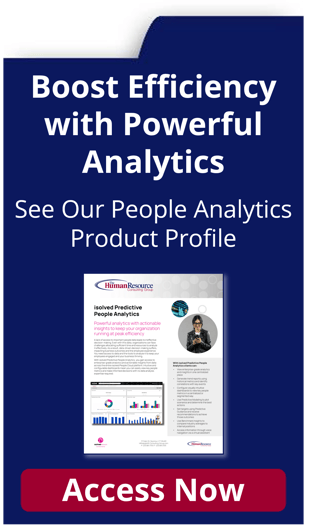An HR Audit is a critical tool in helping organizations evaluate policies and procedures across the organization to identify issues and determine best practices and new directions. Over the last few years, HR professionals have increasingly been turning to HR SWOT Analysis techniques to evaluate these things.
Here is everything you need to know about HR SWOT Analysis.
What is an HR SWOT Analysis?
SWOT stands for Strengths, Weaknesses, Opportunities, and Threats. A SWOT analysis is a technique for assessing these four aspects of a business’s function. Aiming to thoroughly investigate and analyze what an organization is lacking or missing, and developing strategies and tactics to maximize business outcomes going forward.
An HR SWOT Analysis assists organizations in quickly identifying best practices and areas where improvements are needed, so they can quickly make corrections and limit regulatory liability that can arise from non-compliance.
It's typically less lengthy and involved than a typical HR audit, especially when outsourcing or for small and mid-sized businesses that may not have the resources or time to conduct a comprehensive HR Audit.
Using HR SWOT Analysis for an HR Audit
An HR audit is a process of objectively examining a business's HR policies, practices, and procedures. It's an opportunity for companies to re-evaluate their current HR practices and identify weak spots and potential threats to further improve the effectiveness of the HR function, avoid legal risks, and ensure compliance.
HR audits report on what a company is doing right, what it could be doing better, and how competitive its current HR practices and policies are, both internally and externally, shedding light on its competitors and the industry status quo. This is why SWOT techniques can prove very helpful in performing an HR Audit.
How to Conduct an HR SWOT Analysis?
HR audits, or an HR SWOT Analysis, can be conducted internally or externally.
When done externally, companies typically turn to an HR Service Company that can provide a structured process with a team of experienced professionals.
What to Look for...
There are several types of HR audits, each with different goals. Some include:
- Compliance Focused
- Identifying Best Practices
- Evaluating Strategy
- Function-Specific
By taking advantage of an HR SWOT Analysis strategy, businesses can focus their HR audits on more than one goal at a time.
HR SWOT Analysis Strategy
Conducting an HR SWOT Analysis is a fundamental step in aligning business objectives and HR initiatives to achieve organizational growth and success, as well as providing a functional guide on building HR policies, procedures, and structure. Put simply, both tools can help identify whether an HR department's specific practices and policies are adequate, legal, and effective. As such, it's important to understand how to effectively conduct one.
An HR SWOT Analysis has several core focuses:
- Looking inward and identifying what the business is doing both well and where improvement is needed in its HR-related practices.
- Looking externally and identifying what other best practices and challenges - or threats - may be on the horizon, such as regulatory changes.
In terms of the steps to conduct an effective HR SWOT Analysis, organizations should:
- Identify Goal(s), Objective(s), and Focus
- Determine the Audience
- Collecting Data
- Take Action
Identify Goal(s), Objective(s), and Focus
The very first step of conducting an HR SWOT analysis is to identify the organizational goals and objectives of the analysis.
Are you trying to ensure compliance and avoid legal risks? Are you looking to boost employee performance?
Your goals determine what your HR SWOT analysis will focus on and what procedure it will follow, as well as the audience, techniques, rationale, measurements, and costs.
An HR SWOT analysis typically analyzes the following business functions
- Culture and Employee Engagement
- Employee Development
- Employee Relations
- Compliance
- Health and Safety
- Hiring and Staffing
- Benefits
- Performance Management
- Record Keeping and Compliance
- Termination and Offboarding
Determine the Audience
Companies need to determine what audience their HR SWOT analysis will target, which is directly affected by the focus of the analysis. In general, your audience includes who or what part of your organization you hope to review and have an impact on.
For example, if your HR SWOT analysis aims to identify compliance risks, the primary audience may not include the employees. Instead, it will focus on the HR department, executives, or managers.
On the other hand, if your HR SWOT analysis is designed to identify gaps in your current policies regarding benefits packages, PTO, or performance reviews, the audience may include a cross-section of employees.
Collecting Data
Depending on the type of data and information needed to be collected for a company’s HR SWOT analysis, the data collection methods could vary.
Standard data collection practices usually involve:
- Surveys or questionnaires
- Interviews with appropriate staff members
- Documentation review
The audit team should carefully draft a comprehensive document that covers each subject of the audit and addresses all the questions that need an answer from the audience. It is also helpful to re-review or gather any existing documentation done in the past toward achieving the same or similar goals, such as a previous or incomplete analysis.
Using HR Reporting and Analytics Software can have a huge impact on not only streamlining the process of your HR SWOT Analysis, but also help ensure that you are thorough and gathering all needed data.
Take Action on Your HR SWOT Analysis
Once you have gathered all the data you need, the next step is to fix "the bad" and optimize "the good.”
Whoever conducts your HR SWOT Analysis should summarize all findings in the form of a report that lists areas of risk and improvement, as well as areas of strength and optimization opportunities.
With the review and approval of the HR department and executives of the company, an action plan can be created and implemented.
Fixing "the Bad"
Companies should focus on implementing any changes to "Fix the bad" as soon as they can. This is often where you can see the greatest and most immediate impact, as opposed to focusing on optimizing "the good" first.
This goes for small and mid-size companies that do not have a full HR team. Larger businesses, or businesses with an outsourced HR provider, may be able to focus on both at once.
Optimizing "the Good"
The first step toward taking advantage of what you are already doing well is to examine the feedback collected from the analysis so that you can understand how and why certain things are working well. You don't want your optimization efforts to work against you.
Once you have done so, you should look at strategies that may improve existing areas of strength, and that you are certain will not impact what's made it an area of strength in the first place.
Find an HR Company to Help with HR SWOT Analysis
Conducting an HR SWOT Analysis, and then taking action on your findings, is a large project even for an organization with a fully functioning HR department.
As such, many smaller, mid-sized, and even some large businesses don't have the time or resources to conduct one. Luckily, most HR Outsourcing Services can help.
To learn more about how HRCG can help you conduct an HR SWOT Analysis, contact us today.
Author: Lisa Pollock
.png?width=156&height=156&name=Lisa%20Pollock%20(Circle).png) Lisa Pollock is the Vice President & Chief Human Resource Officer at The Human Resource Consulting Group and oversees the HR Business Partner Group and HR Operations. She has more than 25 years of experience in human resources, with expertise in building infrastructures for growing businesses focusing on HR compliance, talent acquisition, and implementing best practices. Lisa has extensive experience in industries such as municipalities, non-profit organizations, manufacturing, professional services, and retail.
Lisa Pollock is the Vice President & Chief Human Resource Officer at The Human Resource Consulting Group and oversees the HR Business Partner Group and HR Operations. She has more than 25 years of experience in human resources, with expertise in building infrastructures for growing businesses focusing on HR compliance, talent acquisition, and implementing best practices. Lisa has extensive experience in industries such as municipalities, non-profit organizations, manufacturing, professional services, and retail.





